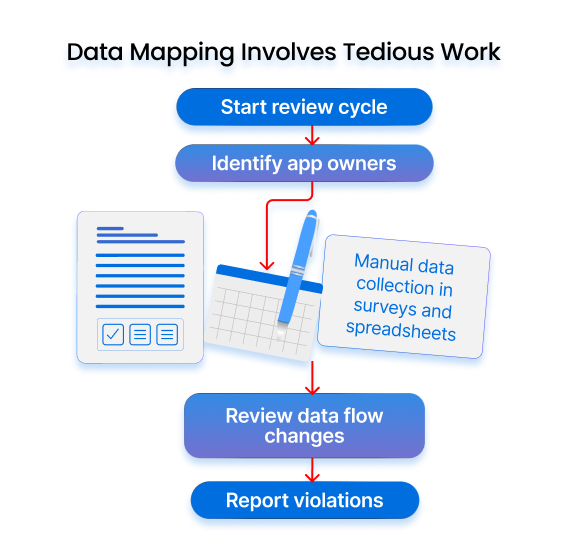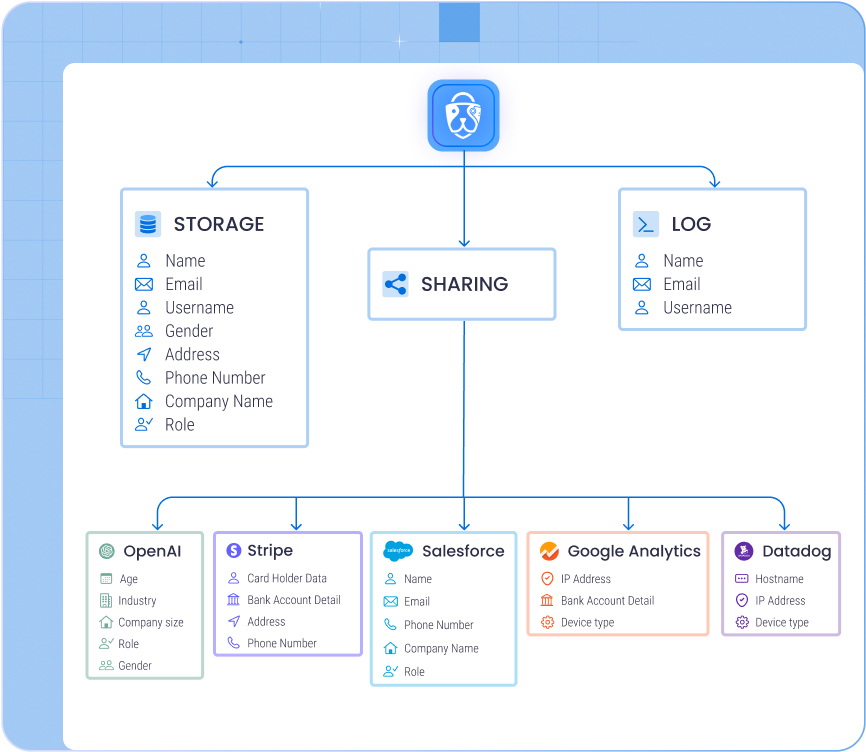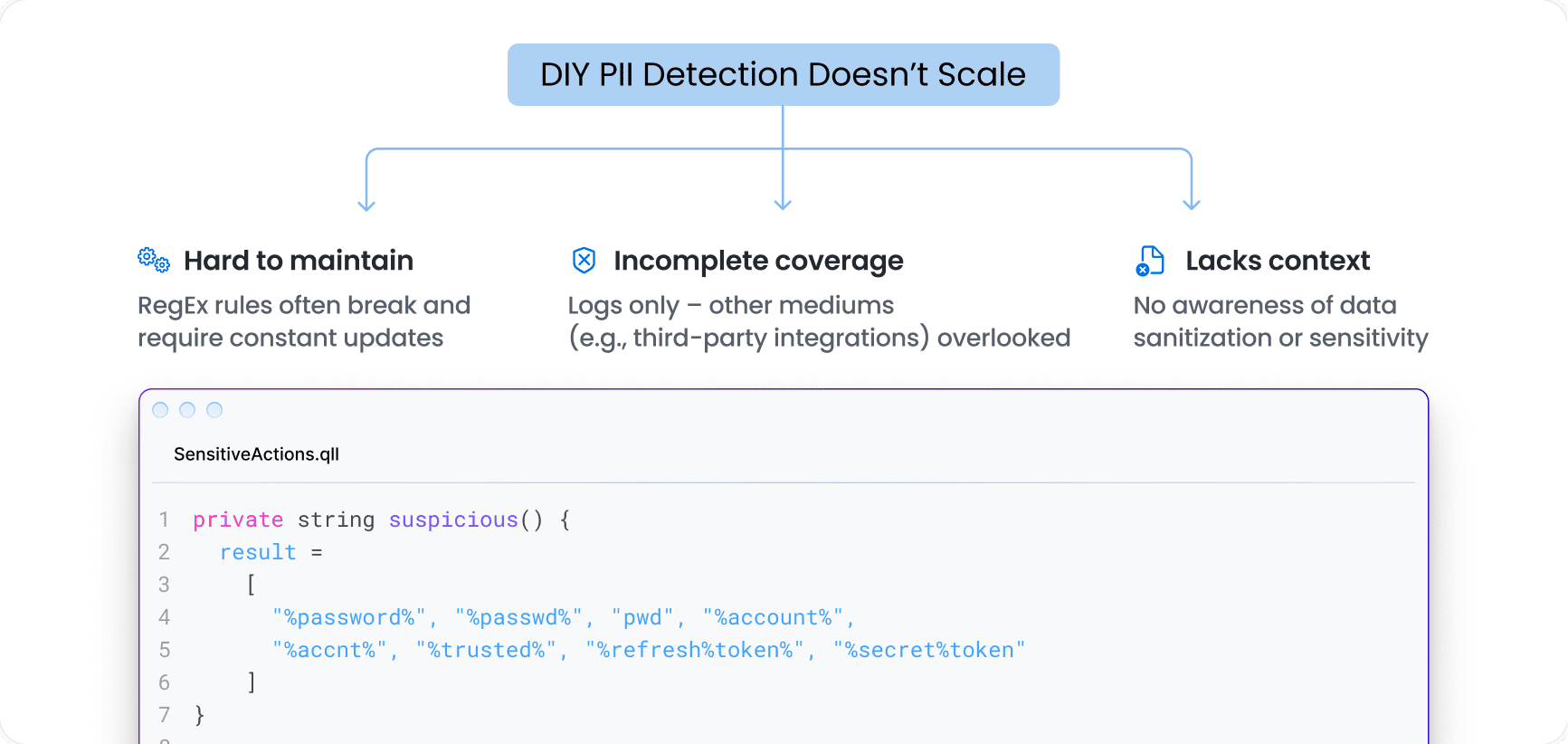Shift-Left Privacy Compliance Automation
Make Privacy-by-Design a Reality in Your SDLC
Using a data privacy platform is a step up from manual mapping—but all are reactive, flagging risks only after data hits production.
HoundDog.ai flips the model by starting with code. Our privacy code scanner delivers:
🚨 Proactive detection of privacy issues like PII/PHI overlogging—before deployment
💻 A definitive, code-level view of your application’s data flows across all storage layers and third-party integrations
🚫 Early DPA violation detection to stop risky data sharing with third-party integrations before it becomes a costly compliance issue
⚙️ Automated RoPA, PIA, and DPIA generation
Evidence-based Data Mapping & Proactive PII Leak Prevention
Non-compliance can lead to regulatory fines, business disruptions, damaged brand loyalty, and loss of customer trust. Unfortunately, privacy and compliance teams are often short-staffed and burdened with constantly updating outdated data maps due to frequent code changes and the fast pace of development.
Using a data privacy platform for mapping and reporting is a step up from manual efforts—but these tools remain reactive, offering insights only after data reaches production. They’re also unreliable due to sampling limitations. Most critically, even when PII is detected in risky mediums (e.g., logs or files), such tools often lack context on the root cause, making remediation significantly more difficult and costly.
As a result, data maps become inaccurate, and PII leaks often go undetected. For instance, when PII leaks into logs—a clear violation of GDPR (Articles 5 and 32), CCPA/CPRA, and HIPAA—relying on DLP or traditional privacy platforms is reactive, unreliable, and painfully slow. Teams may spend weeks scrubbing logs, assessing exposure across every tool that ingested them, and patching code after the fact.
HoundDog.ai flips the model by analyzing code early to catch unintentional developer mistakes—such as overlogging or oversharing sensitive data—before it ever reaches production. This prevents privacy violations before they occur.
Our privacy code scanner delivers evidence-based data mapping and visualization, maintaining a continuously updated PII inventory at the speed of development. It provides visual proof of where sensitive data is stored, shared, and processed. The platform detects DPA violations caused by sensitive data oversharing with third-party integrations early—avoiding costly production issues—and automates RoPA, PIA, and DPIA generation.
In short, HoundDog.ai empowers privacy teams to enforce privacy-by-design from day one and stay ahead of rising PII risks to ensure compliance with GDPR, HIPAA, CCPA, and beyond.
$2.22B
total fines imposed due to GDPR violations in 2023
2.71t
cost of non-compliance is 2.71 times higher than the cost of compliance
The Problem
Privacy & Compliance Teams Struggle to Keep Up With Rapid Product Development
Manual Data Mapping Can’t Keep Up. Compliance teams rely on tedious surveys and spreadsheets, resulting in incomplete and outdated data maps that fail to reflect the latest code updates.
Third-Party Data Blind Spots. Most organizations lack visibility into the types of PII shared with third-party integrations, increasing the risk of unnoticed leaks and DPA violations.
AI Exacerbates PII Risk. AI applications introduce multiple interaction points and abstraction layers, making tracking and controlling sensitive data exposure even more challenging.

The Solution
Start PII Leak Detection And Data Flow Mapping Where It Matters Most: In the Code
Shift Left on Privacy to Keep Up with Development and Catch Privacy Compliance Violations Before They Happen
-
Privacy by design can be overwhelming – we’re here to help
-
Evidence-based data mapping & visualization. Track PII, PHI, and CHD data flows across all storage mediums and third-party integrations. Maintain a continuously updated PII inventory at the pace of development, with visual proof of where data is stored, shared, and processed.
-
Proactive detection of DPA violations. Catch data processing agreement (DPA) violations caused by sensitive data oversharing with third-party integrations early—avoiding costly production issues
-
Automated RoPA, PIA, and DPIA generation
-
New PII/PHI alerting. Get real-time alerts when new PII/PHI data elements are introduced to the codebase, categorized by sensitivity level


Enabling PII Leak Detection & Data Mapping Across All Stages of Development
IDE PLUGINS. (VS Code IntelliJ and Eclipse)
- Highlights PII leaks as code is being written
Managed Scans
- Offload scanning to HoundDog.ai with direct source control integrations
CI/CD Integrations
- Integrate the scanner into CI pipelines for pre-merge checks.


DIY PII Detection Doesn’t Scale
Hardcoded RegEx rules break easily and are a nightmare to maintain. Most DIY efforts stall before they scale

HoundDog.ai: Purpose-Built for PII Detection & Data Mapping
Unparalleled Coverage and Accuracy
Built-in detection with extensive coverage across:
- Sensitive data elements (PII, PHI, PIFI, CHD)
- Risky data sinks (including hundreds of third-party integrations)
- Sanitization functions (flag only when data isn’t properly sanitized)
Endless Flexibility
- Finetune detection across data elements, sinks, and sanitization to fit your environment.
Ready to Scale
- Connect to GitHub, GitLab, or Bitbucket to scan code, block PRs, and leave actionable comments—automatically.
- Managed Scans: Offload scanning to HoundDog.ai for continuous, hands-off coverage
- CI Jobs: Push CI configs to selected repos using your self-hosted runners, with options for direct commits or approval-based PRs
AI-Ready
- AI-powered detection that plugs into any LLM running in your environment—boosting coverage across data elements, sinks, and sanitization, while minimizing manual tuning. (Coming in Q2 2025)
Realize Significant Cost Reduction and Increased Productivity
ROI for automated privacy compliance
Make Privacy-by-Design a Reality in Your SDLC
Shift Left on Privacy. Scan Code. Get Evidence-Based Data Maps. Prevent PII Leaks in Logs and Other Risky Mediums Early—Before Weeks of Remediation in Production.